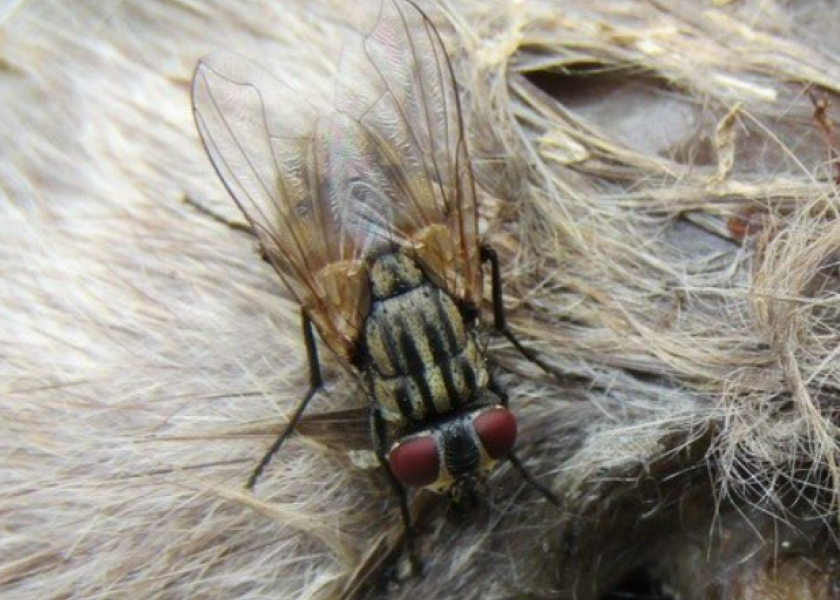Prime Time for Fighting Flies

As temperatures go up in the summer, fly numbers and the health problems they can cause do, too.
Veterinarians can provide an important service to clients by helping them develop a seasonal fly-control program on the dairy and in heifer-raising operations, says Rick Hack, a veterinary consultant trained in entomology.
“Elimination of all breeding areas is really not feasible to prevent adults from repopulating,” he says. “But controlling larvae is a proactive preventative measure so adult flies do not lay eggs and repopulate. Managing both larvae and adults is a continuous process.”
Areas To Address
Routine premise sprays and fogs can keep fly numbers low in confined spaces, but targeted source reduction through debris management outdoors is a more sustainable approach, according to Roger Moon, University of Minnesota entomologist and professor emeritus. He addressed the issue during an I-29 Moo University dairy webinar in 2021.
Moon says some parts of the farm need to be cleaned up on a regular basis. Consider manure that is not removed frequently, decaying garbage and silage, commodity bays with spoiled feed, long grass around buildings, manure storage areas and even nearby wooded areas.
Another key is simply identifying the type of fly that is prevalent in the milking herd, calf hutches and heifer pens.
Here’s a look at four common flies on the dairy:
1. Horn Flies. Horn flies are most typically found on the backs and bellies of cattle, and they are the No. 1 pest of pastured cattle. When feeding, they pierce the skin of cattle with painful bites to ingest blood, and they can feed 20 to 30 times per day. Production is impacted with as few as 200 horn flies on a cow, according to Cornell University researchers. They report it’s not uncommon to have a thousand horn flies on a single animal with product losses up to 15%.
2. Stable flies. These pests are typically found on the legs of cattle, and they face upwards when feeding. Just five flies per leg can cause economic loss, with some studies showing a milk loss of more than 3 lbs. per cow per day. Feed efficiency also drops. “Cattle can exhibit avoidance behavior that reduces the time spent feeding and resting,” Hack says.
3. Face flies. As the name indicates, these flies are typically found on the face and head of animals. Pinkeye transmission is their claim to fame, says Hack.
4. House flies. While considered a nuisance, house flies can carry more than 100 diseases including pinkeye, mastitis, bacterial scours, typhoid, anthrax, vibriosis and several clostridial diseases. They can also transmit antibiotic-resistant bacteria and increase bacteria counts in milk. Adult house flies can be found just about anywhere in buildings, and especially around windows.
Four-Step Plan
Controlling flies requires an integrated management plan that includes inspection, sanitation, treatment and monitoring.
Inspection means identifying which type of fly or flies is most prevalent on the operation.
Sanitation requires on-going daily and weekly efforts to keep the facility as clean as possible to reduce breeding sights. Help producers create a map of their facilities that identifies problem areas, and then routinely ensure these areas are cleaned frequently, says Hack.
Monitoring simply means incorporating routine inspections to check fly populations to determine if the sanitation and treatment program is working.
Treatment requires applying the right product in the right way for the right fly. “Your treatment program should include larvicides used in conjunction with adulticides that will act on multiple life cycle stages and provide more successful fly management results,” Hack says. “Use larvicides continually and adulticides when needed.”
If you only treat adult flies, you will be behind the curve and never catch up. That’s because adults represent just 20% of the fly’s life cycle. So if you just treat adults, larvae will simply continue maturing and contributing to the problem.
Larvicides include spinosyns, growth regulators and organophosphates. Adulticides include pyrenthroids, neonicotinoids, spinosyns and organophosphates.
“It’s important that you don’t use the same type of insecticide on larvae and adults at the same time to prevent the build-up of resistance,” Hack says.
You must also read and know the label of each product, and which class of animals—lactating or non-lactating—for which each product can be used.







